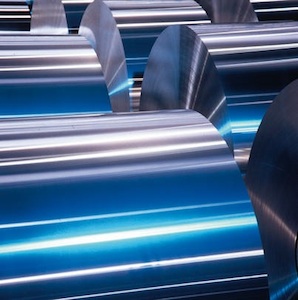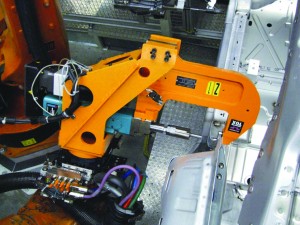 As aluminium becomes increasingly used by carmakers, Mark Simms looks at the mechanical methods required to join this material
As aluminium becomes increasingly used by carmakers, Mark Simms looks at the mechanical methods required to join this material
Ever increasing pressures to reduce fuel consumption and vehicle emissions have seen a raft of technical innovations introduced to the automotive industry, but ultimately it is weight that has the single biggest impact. It is easy to understand, then, the interest in lightweight materials such as aluminium, plastics, composites and new aluminium alloys for body-in-white (BIW) applications.
Aluminium and its alloys in particular have great attractions for automotive body structures: aluminium is about one-third the weight of steel, and while steel is ultimately stronger, comparable or better body strength can be achieved in aluminium at a much lower weight. In addition, aluminium is inherently more corrosion resistant.
A switch to aluminium for automotive body applications is not an easy decision, however. For one thing, aluminium costs significantly more. Yet that is not an insurmountable challenge when consumers are prepared to pay higher prices for a vehicle that will return notably better fuel consumption. Perhaps more importantly, the welding processes that are used with steel cannot simply be transferred to aluminium.
Compared with steel, the melting point of aluminium is much lower and it has a higher thermal conductivity, meaning that traditional welding techniques are highly likely to damage the panels. In addition, the aluminium oxide layer at the surface of the panel leads to a weld that is weak and has a low fatigue resistance, potentially compromising safety.
Welding costs are also greater because the high electrical conductivity of aluminium increases the electrical current requirement. Also, the advantage of aluminium in forming a corrosion-resistant oxide at its surface becomes a disadvantage when it comes to welding, as the reaction of the oxide during the welding process quickly contaminates the spot welding tip, reducing its life and so again pushing up welding costs.
Alternatives for aluminium

Increasingly the focus is on mechanical joining technologies, with four methods most often under consideration: adhesives, self-pierce rivets, clinching and flow drill screws. In 2013, Alcoa produced a presentation looking at the common methods and compared their properties with resistance spot welding. The study showed that, as might be expected, all methods produced a better mechanical performance and that all had a higher consumable cost.
But beyond that, performance was broadly comparable in terms of parameters such as the need for surface presentation (with the exception of adhesive bonding), potential for automation, process speed, compatibility with adhesives and alignment precision. As an important benefit over resistance spot welding, all of the mechanical alternatives allow for bonding of dissimilar materials, such as aluminium to steel or aluminium to composite.
Self-pierce riveting leads the way
Of the most common mechanical joining methods, self-pierce riveting is by far the most widely adopted. Strong enough to be used for joining structural components, and with the ability to be highly automated, self-pierce riveting has been proven to meet the requirements of the automotive industry.
A single-step technique, the self-pierce riveting process punches a semi-tubular rivet into two sheets of material. The self-pierce rivet pierces the upper layer of material, and as it does so the die shape causes it to flare within the lower layer to form a clinched mechanical joint. As the name suggests, pre-drilled holes are not required, allowing a high-strength joint to be formed in a single operation. There is little or no damage to pre-coated materials.

Suppliers also offer tips for the successful use of self-pierce rivet technology, in particular with reference to the direction of rivet insertion where different materials or thicknesses are involved. For best joint integrity, the self-pierce rivet should be inserted from the thin material into the thick, and from the hard into the soft.
Self-pierce riveting of aluminium bodies is already being used by some of the biggest names in the business, including Jaguar Land Rover (JLR) and Audi. Jaguar’s XJ, XK and new F-Type are all constructed from aluminium and assembled using self-pierce riveting, as is the latest Range Rover. For its part, Audi uses self-pierce riveting on both the A8 and A2 models.
HSPR & Riveset self-pierce technology
One of the leading exponents of self-pierce rivet technology is Henrob, which has a client list that includes BMW, Audi, Jaguar, Volvo, Mercedes and Hyundai. In 1994 Audi used Henrob’s pre-clamping self-pierce riveting system for the majority of the Audi A8’s single point joints, and in 1999 the same system was used for various parts of the Audi A2. Henrob technology is also in evidence at Jaguar, which first implemented a self-pierce system in 2001 for the aluminium-bodied X350, developed by Henrob and using Kawasaki robots to apply the rivets. When the system was re-evaluated in 2005, Jaguar concluded that self-pierce riveting still presented the best solution for joining aluminium.
Henrob’s self-pierce riveting technology, HSPR, promises fast cycle times, low energy demands and can be used after coating or painting with virtually no aesthetic or other damage. The process is highly repeatable, and can be readily used with automatic rivet feeds that allow continuous production.
Another leading name in self-pierce riveting technology is Bollhoff, which offers a Rivset system that is suitable for use with aluminium (pressure-cast, extruded and sheet), as well as steel, and is also appropriate for use with different material combinations, including magnesium, copper, films, metal mesh, plastic and sandwich materials. Bollhoff says that as well as joining steel sheets each of 1.0mm thickness, or aluminium sheets each of up to 3.0mm thickness, Rivset will also join combinations of materials. These include: 1.0mm steel sandwiched between 1.2mm aluminium; or 1.2mm aluminium to 1.5mm magnesium; or 2.0mm plastic to 2.0mm aluminium; or 3.0mm plastic to 3.0mm aluminium; or aluminium to aluminium with an adhesive middle layer.
Bollhoff’s Rivset system is now in its second generation, promising a halving of the process time during the joining of mixed materials and high-strength steels (HSS). It enables a process cycle time of better than 1.5 seconds, depending on the setting tool, and provides rivet length control to within ±0.25mm. Furthermore, Bollhoff says that optimised configuration management, with the possibility of customised configurations, means low investment costs.
Setting tool size and weight have been reduced, presenting a load to the robot of 80kg yet providing a maximum setting force of 78kN. The tool has a C-frame design with a throat depth of 500mm as standard or 750mm in the light frame design, providing a great deal of flexibility when positioning the tool in and around automotive body structures. The tool uses a hydraulic cylinder for its motive force, with a design that ensures the best possible lifetime for the cylinder with lower maintenance costs.
Bollhoff’s tool can deliver 60 rivets per minute and has a storage capacity of around 15,000 rivets. The control system provides local hardware configuration with central control of machine components over a bus architecture, with an open interface that supports all of the standard protocols used by the typical automotive production robots. Options include a panel PC to give operators local control via a touch screen, while manual control is also available with complete visualisation of the process.
The control system also enables process data from multiple self-pierce riveting systems to be displayed on the central control system, analysed and archived, guaranteeing full documentation of process data over the production period and traceability over the lifetime of the vehicle.
Both Henrob and Bollhoff offer monitoring systems for their self-pierce rivet tools, tracking the force and punch movement throughout the riveting process. The results are compared with a pre-defined reference to give a pass or fail for the joint, providing a useful tool in the drive for continued improvement in quality control.
Securing results with ClinchRivet

Particularly suitable for use with thinner sheet materials, the ClinchRivet gives a high-strength joint that the company says is superior to self-pierce riveting in terms of both tensile strength and shear strength. The ClinchRivet joint obtains its high-strength values from the formed full rivet firmly positioned in the joint, and the hardening of the sheet metal materials in the neck zone created during the deep-drawing process.
Tox claims that the closed rivet form compared to the semi-open, self-pierce rivet offers advantages in that there is no need for any adhesive and no possibility of the creation of air pockets which could cause corrosion. Tox also argues that the ClinchRivet is less sensitive to negative production influences such as clearance between the sheets, misalignments and the use of adhesives. Provided the punch side stripper force is sufficient, the existence of a small gap between the metal sheets will not impact the joining strength.
For automotive applications, Tox offers a robotic unit with a rivet supply module. The supply module holds approximately 600 rivets in a magazine tube, and the robotic unit docks with this magazine when required and is filled with some 200 rivets. A modular design allows the quick and simple exchange of components.

Within its clinching technology, Tox also offers Round Joint, in which a simple round punch presses the materials to be joined into a die cavity. As the force continues to increase, the punch side material spreads outwards within the die side material. Round Joint enables 30-60% cost savings compared with spot welding, and achieves up to 70% of the static strength of a spot weld – without any screw or rivet.
Tox clinching technology is used in numerous applications throughout the automotive industry, perhaps most notably on the Audi TT. The Round Joint was considered during the development of the TT and selected as an efficient and economic solution for the production version. Through subsequent Coupé and Roadster iterations, Tox clinching technology was used in numerous areas, often combined with glueing in highly automated robot cells.
Challenges remain
A common thread through all the examples discussed so far, however, is that the vehicles in question are not mass-market models, so perhaps this is why doubts have lingered over the viability of aluminium. But that could be set to change with the news that Ford’s 2015 model F-150 pickup truck will be made from this material. Compared with a luxury saloon which might see sales of 10,000-15,000 in a year, the F-Series pick-up trucks sold more than 760,000 units in 2013. This will surely represent a sea change in attitudes towards aluminium vehicle construction.
This is not to say that all challenges have evaporated. The big advantage of welding is its flexibility on the production line, enabling multiple platforms to be assembled on the same line. In its 2013 presentation, Alcoa pointed out that aluminium assembly lines tend to be single platform, and that it might be some time before there are self-pierce rivet or clinching assembly lines that can produce multiple platforms, or single-platform mixes of aluminium and steel vehicles, or production lines that can assemble mixed-material, multi-platform vehicles. With spot welding, multiple models can flow down a single line, and each gun dynamically changes its weld schedule to accommodate different vehicle requirements. OEMs can make gauge changes without downtime or capital costs to retool. Such flexibility is much more difficult to achieve with mechanical joining technologies.

A look under the paintwork of the Audi TT – which combines sheet steel parts with aluminium castings, aluminium extruded sections and aluminium sheet-metal parts in the body structure – reveals no fewer than eight joining methodologies, including punch riveting, clinching, MIG welding, resistance spot welding, adhesive bonding, solid punch riveting, flow drill screwing and aluminium laser welding. Then there is the Audi Crosslane concept, presented at the Paris Auto Show in 2012, which added carbon fibre composites and carbon fibre reinforced composites into the multi-material mix, so bringing further complexity to the joining methodology.
As noted earlier, the Ford F-150 looks set to be a game-changer, bringing aluminium body structures to a mass-market platform. But a challenge for the industry as a whole is to extend that ethos into a wider range of volume production vehicles, and on multi-platform assembly lines. As the Audi TT illustrates, that may well mean embracing a whole raft of different joining methodologies, and looking at how best to combine them in automated assembly processes.


































